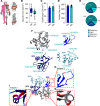Oxidative hotspots on actin promote skeletal muscle weakness in rheumatoid arthritis
- PMID: 30920392
- PMCID: PMC6538353
- DOI: 10.1172/jci.insight.126347
Oxidative hotspots on actin promote skeletal muscle weakness in rheumatoid arthritis
Abstract
Skeletal muscle weakness in patients suffering from rheumatoid arthritis (RA) adds to their impaired working abilities and reduced quality of life. However, little molecular insight is available on muscle weakness associated with RA. Oxidative stress has been implicated in the disease pathogenesis of RA. Here we show that oxidative post-translational modifications of the contractile machinery targeted to actin result in impaired actin polymerization and reduced force production. Using mass spectrometry, we identified the actin residues targeted by oxidative 3-nitrotyrosine (3-NT) or malondialdehyde adduct (MDA) modifications in weakened skeletal muscle from mice with arthritis and patients afflicted by RA. The residues were primarily located to three distinct regions positioned at matching surface areas of the skeletal muscle actin molecule from arthritis mice and RA patients. Moreover, molecular dynamic simulations revealed that these areas, here coined "hotspots", are important for the stability of the actin molecule and its capacity to generate filaments and interact with myosin. Together, these data demonstrate how oxidative modifications on actin promote muscle weakness in RA patients and provide novel leads for targeted therapeutic treatment to improve muscle function.
Keywords: Muscle Biology; Rheumatology; Skeletal muscle.
Conflict of interest statement
Figures






References
Publication types
MeSH terms
Substances
LinkOut - more resources
Full Text Sources
Medical
Research Materials

